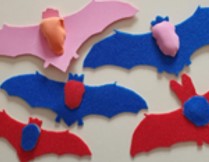by Ruth Cowell
When in early 2022 I volunteered to go batty for my newly formed local Nature Group I had no idea where this would lead me. At first I immersed myself in the Bat Conservation Trust (BCT) training, including 'How to Organise and Run a Bat Walk', which introduced me to other enthusiasts. Then I looked at the wealth of resources available on the BCT website. The 'Bats For All' section references projects which have included hard to reach groups and I was fortunate that some took place in the Avon area where I am based and had a legacy of loanable library resources. I attended a couple of bat walks myself and joined my local bat group.
My big
question was how as a volunteer could I have the resources to run a field bat
walk that did not exclude those with mobility, vision or hearing difficulties?
I had inspiration from the BCT website and an idea of what we needed to achieve
but trying to access owners of historic projects was difficult and I am not an
expert on these issues. I had excellent advice from Trustees of the Bristol
Centre for Deaf and Hard of Hearing who had been involved in previous projects
but the difficulty of gaining consent to use copyrighted resources seemed
insurmountable. Enter my Parish Council.
In Frampton
Cotterell Parish Council we have an enthusiastic Climate and Nature officer who
was already working in partnership with the Nature Group and had a forum for
discussion. We agreed that I would support the development of the resources
needed, that the Parish Council would take ownership of them and that this
would not be a project but would have ongoing review so that resources would
not go out of date. The necessary Committee agreements added time to decision
making but it was worth it.
Tablet with EMT
Our first
goal was to run an inclusive outdoor bat walk event at the end of August which
was accessible to wheelchair users and those with mobility, vision and hearing
difficulties. I had my Echo Meter Touch (EMT) in a computer tablet for hearing
impaired, we already had 3 heterodyne Magenta bat detectors, which I put bumps
on to mark frequencies of 25 and 50 Khz, and we borrowed more detectors. We
focused on the bats most likely to be encountered in our area: noctule, common and soprano pipistrelle, serotine, Daubenton's bat and brown long-eared bat. I made to scale cardboard
tactile bats where the anatomy could be traced and weighted bats which also
demonstrated the different wing shapes. The bat walk went well although the
hearing impaired and wheelchair users had to withdraw for unrelated reasons.
 |
| Cardboard tactile bats |
The next
goal was to make our resources more robust in time for our bat event at the
City Nature Challenge at the end of April 2023. The Parish Council agreed
funding so that we were able to purchase 5 more bat detectors, 2 EMTs and tablets
and to have British Sign Language (BSL) support for a workshop. We produced
instructions for using the Magenta detectors, including the BCT What Bat is That?
large print leaflet, and an audio description of the instructions and leaflet
which included heterodyne bat echolocation sounds taken from my EMT recordings.
We commissioned a Braille and tactile image resource from the RNIB and had
permission from the BCT to include a braille version of the What Bat is That?
large print leaflet and tactile bat outlines from the BCT website. The event went
well and BSL interpretation was used.
This is not
a time limited project with evaluation of a definite outcome but an evolving
case study of how we can build inclusive nature events. Residents can borrow
all the resources from the Parish Council and links have been made with key
network groups. We have just received news of an external grant from the
National Lottery that will enable us to provide more events, including BSL
support, over the next year and we now have a framework for producing resources
to support inclusivity in our other nature activities.






